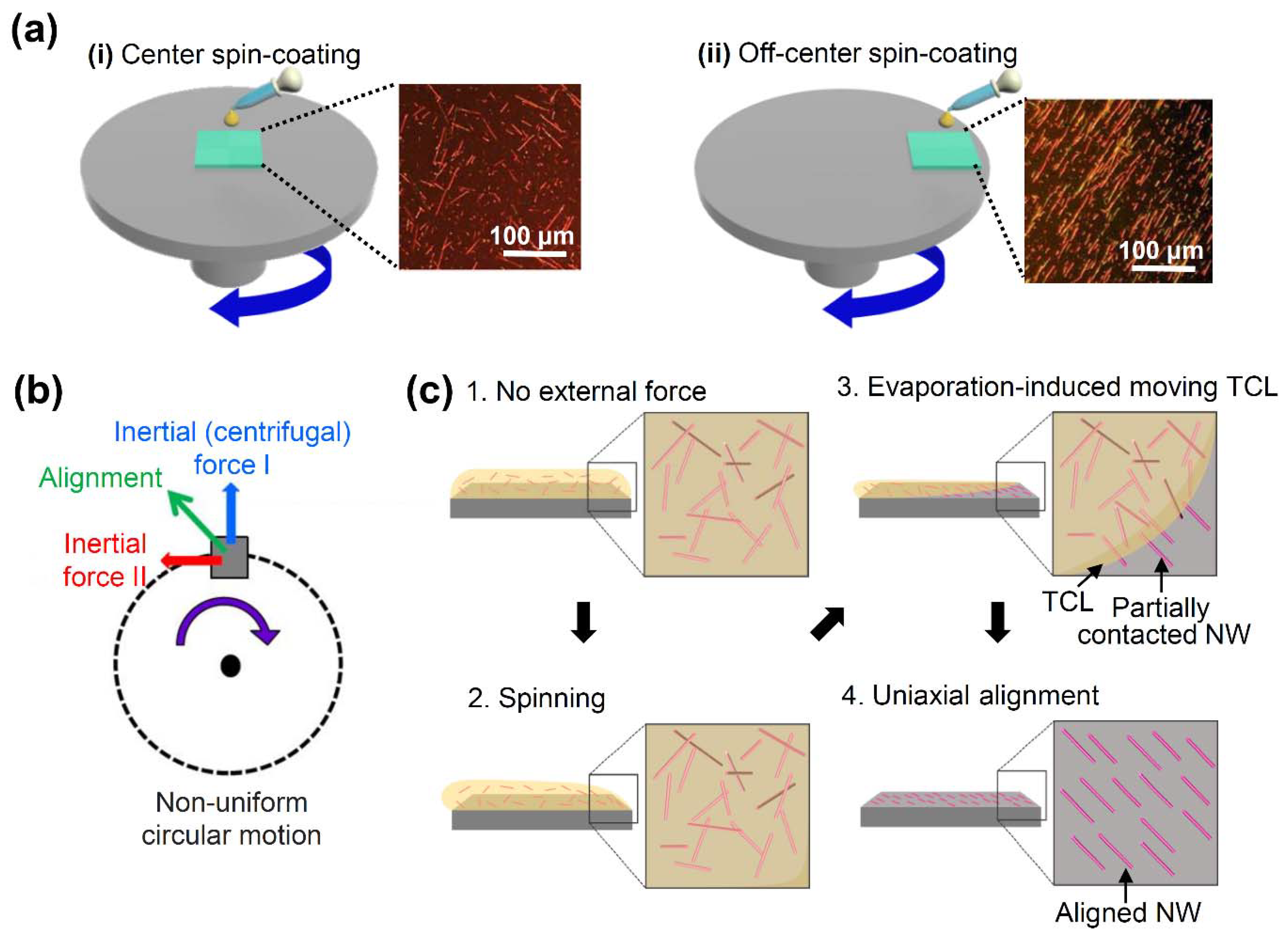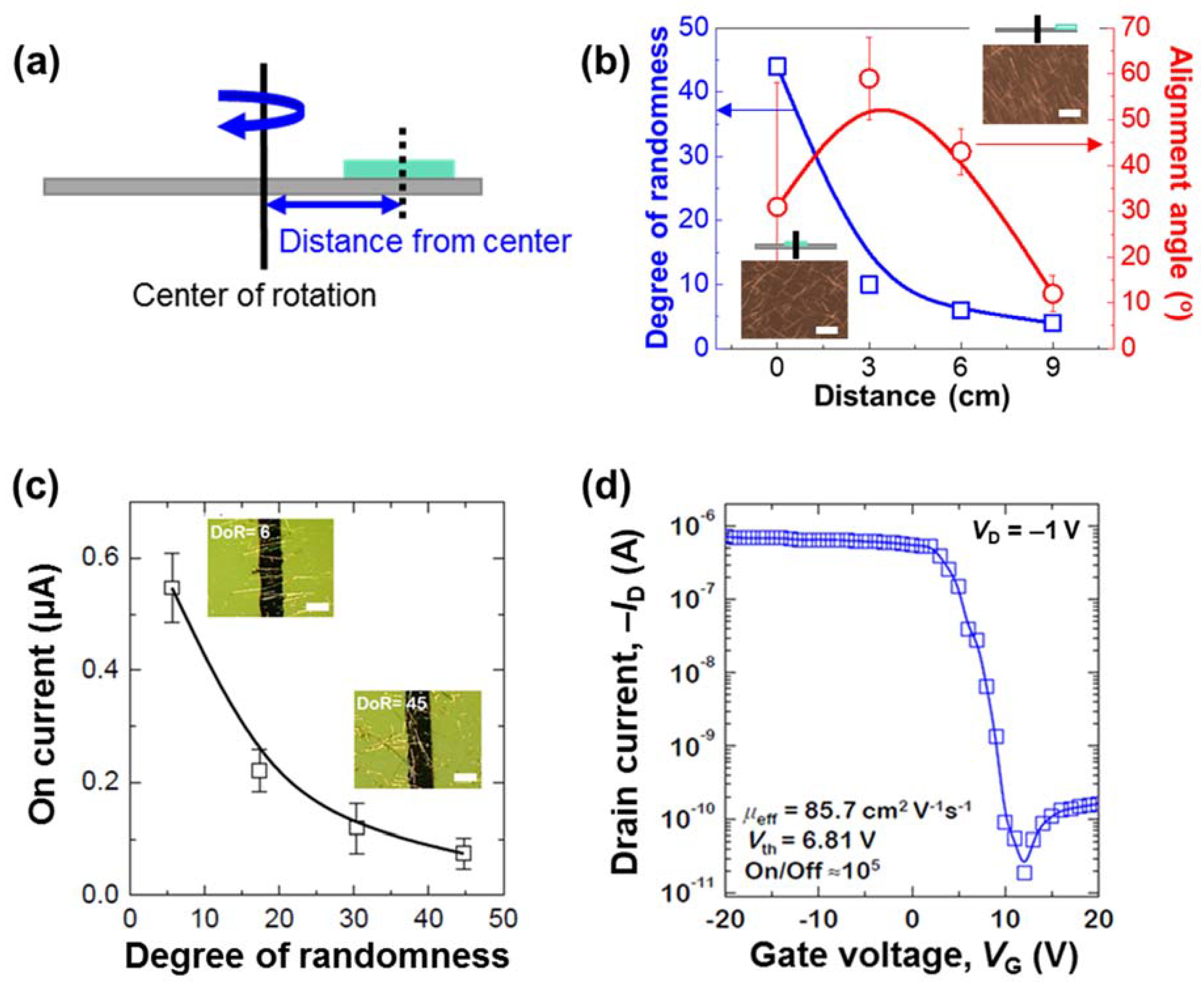Tailored Uniaxial Alignment of Nanowires Based on Off-Center Spin-Coating for Flexible and Transparent Field-Effect Transistors
Abstract
:1. Introduction
2. Results and Discussion
3. Conclusions
Supplementary Materials
Author Contributions
Funding
Data Availability Statement
Conflicts of Interest
References
- Wang, C.; Lu, Z.; Deng, W.; Zhao, W.; Lu, B.; Xiao, J.; Zhang, X.; Jie, J.; Zhang, X. Precise Patterning of Single Crystal Arrays of Organic Semiconductors by a Patterned Microchannel Dip-Coating Method for Organic Field-Effect Transistors. J. Mater. Chem. C 2021, 9, 5174–5181. [Google Scholar] [CrossRef]
- Jinkins, K.R.; Chan, J.; Jacobberger, R.M.; Berson, A.; Arnold, M.S. Substrate-Wide Confined Shear Alignment of Carbon Nanotubes for Thin Film Transistors. Adv. Electron. Mater. 2019, 5, 1800593. [Google Scholar] [CrossRef]
- Nafari, A.; Sodano, H.A. Tailored Nanocomposite Energy Harvesters with High Piezoelectric Voltage Coefficient through Controlled Nanowire Dispersion. Nano Energy 2019, 60, 620–629. [Google Scholar] [CrossRef] [Green Version]
- Cho, S.; Kang, S.; Pandya, A.; Shanker, R.; Khan, Z.; Lee, Y.; Park, J.; Craig, S.L.; Ko, H. Large-Area Cross-Aligned Silver Nanowire Electrodes for Flexible, Transparent, and Force-Sensitive Mechanochromic Touch Screens. ACS Nano 2017, 11, 4346–4357. [Google Scholar] [CrossRef]
- Lee, H.J.; Yang, U.J.; Kim, K.N.; Park, S.; Kil, K.H.; Kim, J.S.; Wodtke, A.M.; Choi, W.J.; Kim, M.H.; Baik, J.M. Directional Ostwald Ripening for Producing Aligned Arrays of Nanowires. Nano Lett. 2019, 19, 4306–4313. [Google Scholar] [CrossRef] [Green Version]
- Lee, G.; Bae, G.Y.; Son, J.H.; Lee, S.; Kim, S.W.; Kim, D.; Lee, S.G.; Cho, K. User-Interactive Thermotherapeutic Electronic Skin Based on Stretchable Thermochromic Strain Sensor. Adv. Sci. 2020, 7, 2001184. [Google Scholar] [CrossRef]
- Lieber, C.M. Nanoscale Science and Technology: Building a Big Future from Small Things. MRS Bull. 2003, 28, 486–491. [Google Scholar] [CrossRef] [Green Version]
- McEuen, P.L. Single-Wall Carbon Nanotubes. Phys. World 2000, 13, 31. [Google Scholar]
- Avouris, P. Molecular Electronics with Carbon Nanotubes. Acc. Chem. Res. 2002, 35, 1026–1034. [Google Scholar]
- Duan, X.F.; Niu, C.M.; Sahi, V.; Chen, J.; Parce, J.W.; Empedocles, S.; Goldman, J.L. High-Performance Thin-Film Transistors Using Semiconductor Nanowires and Nanoribbons. Nature 2003, 425, 274–278. [Google Scholar]
- Cui, Y.; Zhong, Z.H.; Wang, D.L.; Wang, W.U.; Lieber, C.M. High Performance Silicon Nanowire Field Effect Transistors. Nano Lett. 2003, 3, 149–152. [Google Scholar] [CrossRef]
- Duan, X.F. Assembled Semiconductor Nanowire Thin Films for High-Performance Flexible Macroelectronics. MRS Bull. 2007, 32, 134–141. [Google Scholar] [CrossRef]
- Xia, Y.; Yang, P.; Sun, Y.; Wu, Y.; Mayers, B.; Gates, B.; Yin, Y.; Kim, F.; Yan, H. One-Dimensional Nanostructures: Synthesis, Characterization, and Applications. Adv. Mater. 2003, 15, 353–389. [Google Scholar] [CrossRef]
- Huang, Y.; Duan, X.F.; Cui, Y.; Lauhon, L.J.; Kim, K.H.; Lieber, C.M. Logic Gates and Computation from Assembled Nanowire Building Blocks. Science 2001, 294, 1313–1317. [Google Scholar] [CrossRef]
- Cui, Y.; Lieber, C.M. Functional Nanoscale Electronic Devices Assembled Using Silicon Nanowire Building Blocks. Science 2001, 291, 851–853. [Google Scholar] [CrossRef] [Green Version]
- Lieber, C.M.; Wang, Z.L. Functional Nanowires. MRS Bull. 2007, 32, 99–108. [Google Scholar] [CrossRef] [Green Version]
- Chen, X.Q.; Saito, T.; Yamada, H.; Matsushige, K. Aligning Single-Wall Carbon Nanotubes with an Alternating-Current Electric Field. Appl. Phys. Lett. 2001, 78, 3714–3716. [Google Scholar] [CrossRef] [Green Version]
- Smith, P.A.; Nordquist, C.D.; Jackson, T.N.; Mayer, T.S.; Martin, B.R.; Mbindyo, J.; Mallouk, T.E. Electric-Field Assisted Assembly and Alignment of Metallic Nanowires. Appl. Phys. Lett. 2000, 77, 1399–1401. [Google Scholar] [CrossRef] [Green Version]
- Lee, T.I.; Choi, W.J.; Moon, K.J.; Choi, J.H.; Kar, J.P.; Das, S.N.; Kim, Y.S.; Baik, H.K.; Myoung, J.M. Programmable Direct-Printing Nanowire Electronic Components. Nano Lett. 2010, 10, 1016–1021. [Google Scholar] [CrossRef]
- Lee, S.G.; Kim, H.; Choi, H.H.; Bong, H.; Park, Y.D.; Lee, W.H.; Cho, K. Evaporation-Induced Self-Alignment and Transfer of Semiconductor Nanowires by Wrinkled Elastomeric Templates. Adv. Mater. 2013, 25, 2162–2166. [Google Scholar] [CrossRef]
- Lee, G.; Lee, S.G.; Chung, Y.; Bae, G.Y.; Lee, S.; Ryu, S.; Cho, K. Omnidirectionally and Highly Stretchable Conductive Electrodes Based on Noncoplanar Zigzag Mesh Silver Nanowire Arrays. Adv. Electron. Mater. 2016, 2, 1600158. [Google Scholar] [CrossRef]
- Auvray, S.; Derycke, V.; Goffman, M.; Filoramo, A.; Jost, O.; Bourgoin, J.P. Chemical Optimization of Self-Assembled Carbon Nanotube Transistors. Nano Lett. 2005, 5, 451–455. [Google Scholar] [CrossRef]
- Whang, D.; Jin, S.; Wu, Y.; Lieber, C.M. Large-Scale Hierarchical Organization of Nanowire Arrays for Integrated Nanosystems. Nano Lett. 2003, 3, 1255–1259. [Google Scholar] [CrossRef]
- Tao, A.; Kim, F.; Hess, C.; Goldberger, J.; He, R.; Sun, Y.; Xia, Y.; Yang, P. Langmuir-Blodgett Silver Nanowire Monolayers for Molecular Sensing Using Surface-Enhanced Raman Spectroscopy. Nano Lett. 2003, 3, 1229–1233. [Google Scholar] [CrossRef]
- Jin, S.; Whang, D.; McAlpine, M.C.; Friedman, R.S.; Wu, Y.; Lieber, C.M. Scalable Interconnection and Integration of Nanowire Devices without Registration. Nano Lett. 2004, 4, 915–919. [Google Scholar] [CrossRef]
- Yu, G.; Cao, A.; Lieber, C.M. Large-Area Blown Bubble Films of Aligned Nanowires and Carbon Nanotubes. Nat. Nanotechnol. 2007, 2, 372–377. [Google Scholar] [CrossRef]
- Yu, G.; Li, X.; Lieber, C.M.; Cao, A. Nanomaterial-Incorporated Blown Bubble Films for Large-Area, Aligned Nanostructures. J. Mater. Chem. 2008, 18, 728–734. [Google Scholar] [CrossRef]
- Yerushalmi, R.; Jacobson, Z.A.; Ho, J.C.; Fan, Z.; Javey, A. Large Scale, Highly Ordered Assembly of Nanowire Parallel Arrays by Differential Roll Printing. Appl. Phys. Lett. 2007, 91, 203104. [Google Scholar] [CrossRef]
- Fan, Z.; Ho, J.C.; Jacobson, Z.A.; Yerushalmi, R.; Alley, R.L.; Razavi, H.; Javey, A. Wafer-Scale Assembly of Highly Ordered Semiconductor Nanowire Arrays by Contact Printing. Nano Lett. 2008, 8, 20–25. [Google Scholar] [CrossRef] [Green Version]
- Yuan, Y.; Giri, G.; Ayzner, A.L.; Zoombelt, A.P.; Mannsfeld, S.C.B.; Chen, J.; Nordlund, D.; Toney, M.F.; Huang, J.; Bao, Z. Ultra-High Mobility Transparent Organic Thin Film Transistors Grown by an Off-centre Spin-Coating Method. Nat. Commun. 2014, 5, 3005. [Google Scholar] [CrossRef] [Green Version]
- Xia, D.; Biswas, A.; Li, D.; Brueck, S.R.J. Directed Self-Assembly of Silica Nanoparticles into Nanometer-Scale Patterned Surfaces Using Spin-Coating. Adv. Mater. 2004, 16, 1427–1432. [Google Scholar] [CrossRef]
- LeMieux, M.C.; Roberts, M.; Barman, S.; Jin, Y.W.; Kim, J.M.; Bao, Z. Self-Sorted, Aligned Nanotube Networks for Thin-Film Transistors. Science 2008, 321, 101–104. [Google Scholar] [CrossRef]
- Roberts, M.E.; LeMieux, M.C.; Sokolov, A.N.; Bao, Z. Self-Sorted Nanotube Networks on Polymer Dielectrics for Low-Voltage Thin-Film Transistors. Nano Lett. 2009, 9, 2526–2531. [Google Scholar] [CrossRef]
- Kang, L.; Chen, H.; Yang, Z.; Yuan, Y.; Huang, H.; Yang, B.; Gao, Y.; Zhou, C. Seesaw-like Polarized Transmission Behavior of Silver Nanowire Arrays Aligned by Offcenter Spin-Coating. J. Appl. Phys. 2018, 123, 205110. [Google Scholar] [CrossRef]
- Deng, W.; Zhang, X.; Wang, L.; Wang, J.; Shang, Q.; Zhang, X.; Huang, L.; Jie, J. Wafer-Scale Precise Patterning of Organic Single-Crystal Nanowire Arrays via a Photolithography-Assisted Spin-Coating Method. Adv. Mater. 2015, 27, 7305–7312. [Google Scholar] [CrossRef]
- Feng, J.; Xia, H.; You, F.; Mao, H.; Ma, X.; Tao, H.; Zhao, X.; Wang, M.C. Alignment of Ag Nanowires on Glass Sheet by Dip-Coating Technique. J. Alloy. Compd. 2018, 735, 607. [Google Scholar] [CrossRef]
- Munson, B.R.; Young, D.F.; Okiishi, T.H.; Huebsch, W.W. Fundamentals of Fluid Mechanics; John Wiley & Sons: New York, NY, USA, 2002; pp. 461–533. [Google Scholar]
- Zhao, Y.; Marshall, J.S. Spin Coating of a Colloidal Suspension. Phys. Fluids 2008, 20, 043302. [Google Scholar] [CrossRef]
- Yao, Y.; Luo, J.; Liu, h.; Zhu, K. Water Tunnel Experimental Investigation on Drag Reduction of Coating Surface Wall. Procedia Eng. 2015, 126, 247–253. [Google Scholar] [CrossRef]
- Truesdell, R.; Mammoli, A.; Vorobieff, P.; Swol, F.V.; Brinker, C.J. Drag Reduction on a Patterned Superhydrophobic Surface. Phys. Rev. Lett. 2006, 97, 44504. [Google Scholar] [CrossRef]
- Lee, S.B.; Kang, B.; Kim, D.; Park, C.; Kim, S.; Lee, M.; Lee, W.B.; Cho, K. Motion-Programmed Bar-Coating Method with Controlled Gap for High-Speed Scalable Preparation of Highly Crystalline Organic Semiconductor Thin Films. ACS Appl. Mater. Interfaces 2019, 11, 47153–47161. [Google Scholar] [CrossRef]
- Liu, Z.; Yin, Z.; Wang, J.; Zheng, Q. Polyelectrolyte Dielectrics for Flexible Low-Voltage Organic Thin-Film Transistors in Highly Sensitive Pressure Sensing. Adv. Funct. Mater. 2019, 29, 1806092. [Google Scholar] [CrossRef] [Green Version]




Publisher’s Note: MDPI stays neutral with regard to jurisdictional claims in published maps and institutional affiliations. |
© 2022 by the authors. Licensee MDPI, Basel, Switzerland. This article is an open access article distributed under the terms and conditions of the Creative Commons Attribution (CC BY) license (https://creativecommons.org/licenses/by/4.0/).
Share and Cite
Lee, G.; Kim, H.; Lee, S.B.; Kim, D.; Lee, E.; Lee, S.K.; Lee, S.G. Tailored Uniaxial Alignment of Nanowires Based on Off-Center Spin-Coating for Flexible and Transparent Field-Effect Transistors. Nanomaterials 2022, 12, 1116. https://doi.org/10.3390/nano12071116
Lee G, Kim H, Lee SB, Kim D, Lee E, Lee SK, Lee SG. Tailored Uniaxial Alignment of Nanowires Based on Off-Center Spin-Coating for Flexible and Transparent Field-Effect Transistors. Nanomaterials. 2022; 12(7):1116. https://doi.org/10.3390/nano12071116
Chicago/Turabian StyleLee, Giwon, Haena Kim, Seon Baek Lee, Daegun Kim, Eunho Lee, Seong Kyu Lee, and Seung Goo Lee. 2022. "Tailored Uniaxial Alignment of Nanowires Based on Off-Center Spin-Coating for Flexible and Transparent Field-Effect Transistors" Nanomaterials 12, no. 7: 1116. https://doi.org/10.3390/nano12071116





